Annual State of NHSScotland Assets and Facilities Report for 2013
A review of asset and facilities management performance in NHSScotland, identifying the current state of the estate and facilities management, highlighting areas of best practice and areas for improvement.
2.0 NHSScotland's assets
The responsibility for the management of NHSScotland's assets rests with 14 NHS Boards and 8 Special NHS Boards.
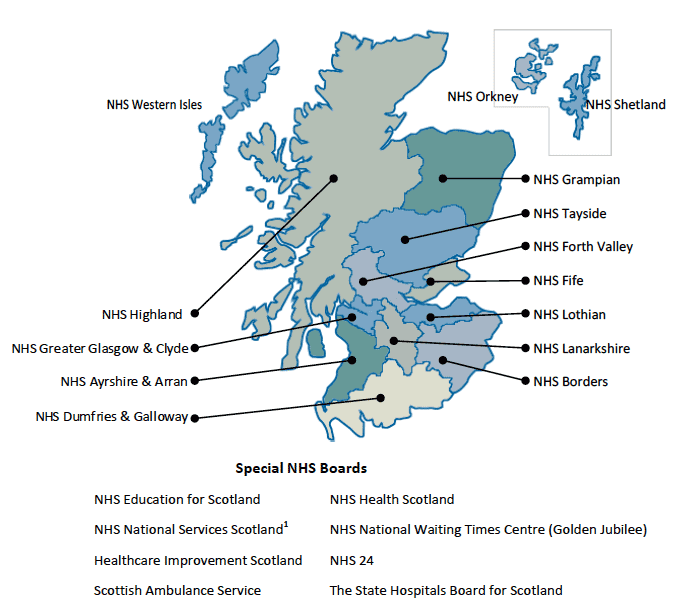
NHSScotland owns physical assets that are worth circa £5 billion. Most of these assets relate to the estate (land and buildings) which are estimated to be worth circa £4.6 billion. Other significant fixed assets which are owned are vehicles, medical equipment and information management and technology (IM&T). An estimate of the Net Book Value of these owned assets is shown in the chart below.
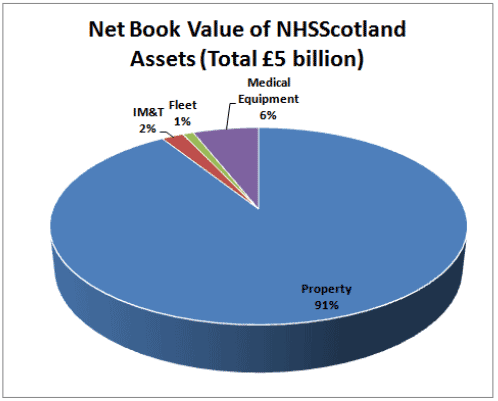
Taken from information returned by each NHS Board
The NHS also leases assets which it does not own including buildings, vehicles, medical equipment and IM&T. These leased assets are estimated to be worth a further £1.5 billion, the majority of which are hospitals and health centres leased under Public Private Partnerships (PPPs) agreements. The majority of cars used by NHSScotland staff are also leased with staff paying for their own non business element of these leased vehicles.
In addition to the NHSScotland owned and leased property assets, there are numerous smaller properties used to provide a range of community and family health services provided by GPs, Pharmacists, Dentists and Opticians, many of which are owned or leased by these independent practitioners themselves and paid for indirectly by the NHS through a range of charging and re-imbursement mechanisms.
2.1 Estate Assets
The NHSScotland estate comprises circa 4.5 million sq.m of building floor area encompassing buildings ranging in size from 40 sq.m to 200,000 sq.m. The majority (75%) of this is the hospital estate of the 14 NHS Boards and 2 Special NHS Boards (NHS National Waiting Times Centre and the State Hospitals Board). The 2012 ISD Cost Book records this hospital estate as 237 hospitals with a total building area of 3.4 million sq.m. Other property types that account for the further 1.1 million sq.m. include health centres & clinics, day centres, offices, residential accommodation, and industrial / storage units.
The charts that follow show an analysis of the hospital estate by type of hospital in terms of building area and the number of sites.
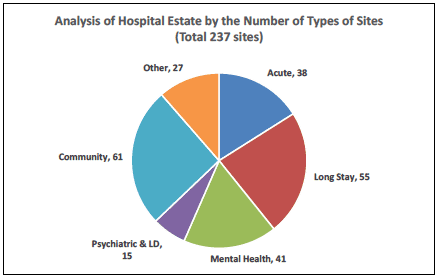
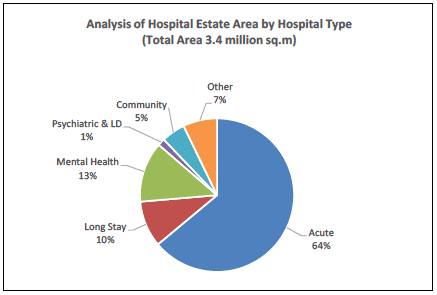
The above charts show that whilst community hospitals are the most numerous (61) they only represent 5% of the total hospital estate in terms of building area i.e. a large number of small hospitals. In contrast, the 38 acute hospitals account for 64% of the total hospital estate in terms of building area.
The overall acute services property asset model (including community hospitals, specialist hospitals such as Golden Jubiliee, and ambulatory care hospitals) is shown diagramatically below.
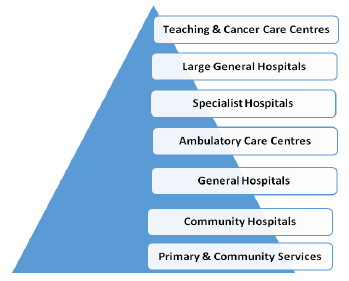
Analysis of this model is shown in the table that follows and clearly illustrates the importance of the Teaching and Large General Hospitals in terms of both their size and expenditure on property and facilities management services. These two hospital types account for 56% of the total hospital estate (area sq.m) and 60% of the total expenditure on property and FM services.
| Acute Services |
|||||
|---|---|---|---|---|---|
| Type |
Number |
Area sq.m |
Property & FM Costs |
||
| sq.m |
Percentage of Total NHS Scotland Hospital Estate |
Annual £ |
Percentage of Total NHS Scotland Expenditure on Property & FM |
||
| Teaching |
7 |
989355 |
29% |
181,680,845 |
28% |
| Large General |
16 |
918533 |
27% |
210,371,579 |
32% |
| General |
11 |
161682 |
5% |
28,606,897 |
4% |
| Children's Hospital |
3 |
93571 |
3% |
13,685,664 |
2% |
| Golden Jubilee |
1 |
42607 |
1% |
7,356,647 |
1% |
| Stobhill ACH |
1 |
27675 |
1% |
15,784,855 |
2% |
| Victoria ACH |
1 |
41722 |
1% |
15,175,310 |
2% |
| Community |
61 |
168717 |
5% |
35,581,691 |
5% |
| Total |
101 |
2,443,862 |
72% |
508,243,489 |
77% |
| Percentage of NHSScotland All Hospitals Estate |
43% |
72% |
77% |
||
The table below shows that the teaching hospitals are concentrated in the major cities of Scotland and particularly in Glasgow and Edinburgh which accounts for 70% of the total teaching hospital estate.
| City |
No Teaching Hospitals |
Area of Teaching Hospitals sq.m |
% of Total Area of Teaching Hospitals |
|---|---|---|---|
| Glasgow |
3 |
431,558 |
44% |
| Edinburgh |
2 |
250,767 |
26% |
| Dundee |
1 |
198,670 |
20% |
| Aberdeen* |
1 |
108,360 |
10% |
| Total |
7 |
989,355 |
100% |
* Area taken from the Cost Book / EAMS data but this does not cover the full Foresterhill Campus
The large general hospitals are more widely distributed across the NHSScotland Boards, as shown below.
| Board |
No of Large General Hospitals |
Area of Large General Hospitals sq.m |
% of Total Area of Large General Hospitals |
|---|---|---|---|
| Glasgow |
3 |
183,805 |
20% |
| Lanarkshire |
3 |
169,874 |
18% |
| Ayrshire & Arran |
2 |
112,692 |
12% |
| Fife |
2 |
106,836 |
12% |
| Forth Valley |
1 |
95,115 |
10% |
| Lothian |
1 |
67,004 |
7% |
| Highland |
1 |
54,203 |
6% |
| Dumfries & Galloway |
1 |
47,851 |
5% |
| Tayside |
1 |
46,243 |
5% |
| Borders |
1 |
34,910 |
4% |
| Total |
16 |
918,533 |
100% |
The table below shows that NHS Grampian and Highland account for over half of the community hospitals, with most located out with the major centres of population.
| Board |
No of Community Hospitals |
Area of Community Hospitals sq.m |
% of Total Area of Community Hospitals |
|---|---|---|---|
| Grampian |
17 |
46,303 |
27% |
| Highland |
14 |
41,130 |
24% |
| Fife |
4 |
21,937 |
13% |
| Tayside |
8 |
21,355 |
13% |
| Ayrshire & Arran |
3 |
13,835 |
8% |
| Borders |
4 |
12,350 |
7% |
| Dumfries & Galloway |
4 |
4,470 |
3% |
| Lanarkshire |
4 |
4,154 |
2% |
| Lothian |
2 |
2,728 |
2% |
| Western Isles |
1 |
455 |
0.3% |
| Total |
61 |
168,717 |
100% |
The chart below shows an analysis of the current NHSScotland hospital estate by building type and compares this to 2002.
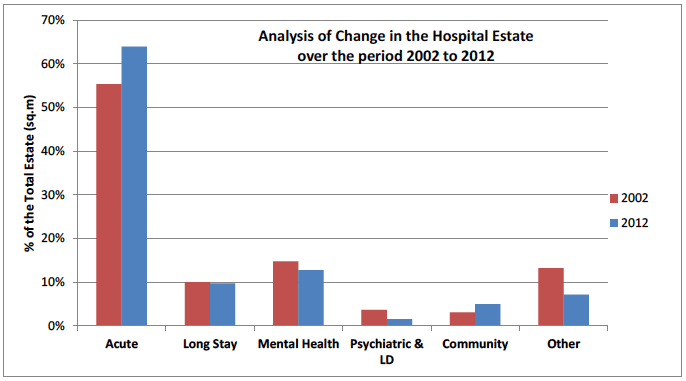
Data Source: ISD Cost Book
The chart shows that acute and community hospitals have both increased in terms of their percentage of the overall hospital estate since 2002 whilst all other types of hospitals have decreased as a percentage of the overall hospital estate.
The increase in community hospital accommodation reflects the extended role of community hospitals in delivering a wider range of services locally. However, the increase in size of the acute hospital estate reflects both higher space standards for new hospitals and the extended range of services required from within them. It is expected that trends towards providing services more locally will be an integral part of the 2020 Vision, and subsequent changes in the estate will continue to be monitored as part of SAFR in future years.
2.1.1 Estate Tenure
The majority of the NHSScotland estate is owned but PPP/PFI and leased properties are also significant as shown in the chart that follows.
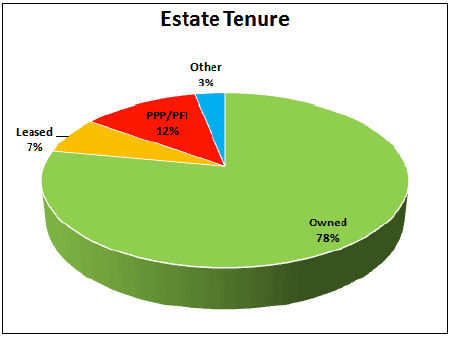
The majority of all office accommodation occupied by the Special NHS Boards is leased.
2.1.2 Estate Age Profile
The chart below shows the age profile of the NHSScotland Estate. It shows that, even though there has been substantial capital investment over recent years, 28% of the estate remains over 50 years old with a further 26% over 30 years old (note that some older properties are refurbished to modern standards rather than replaced). This age profile is similar to that reported in the 2012 SAFR report, with the percentage of properties less than 50 years old only marginally reducing from 73% to 72%.
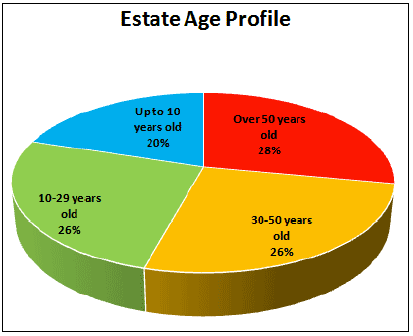
2.1.3 Estate Condition
Approximately 67% of the NHS Boards' estate is in good physical condition (category A or B) with 30% requiring investment to improve its condition (category C) and 3% being unsatisfactory and requiring major investment or replacement (category D).
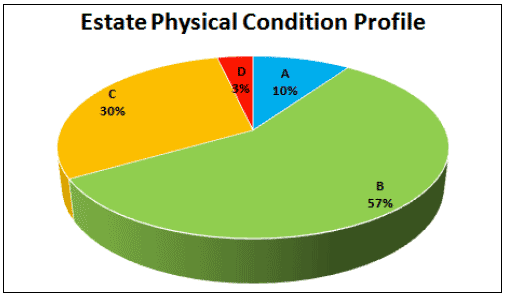
The proportion of the estate in good physical condition (67%) is similar to the proportion of the estate less than 50 years old (72%), thus suggesting that most properties up to 50 years old are capable of being maintained to a good standard.
NHS Boards which have buildings assessed as category D - "unsatisfactory" have indicated that they have plans in place to either dispose or replace these buildings over the next 10 years.
2.1.4 Estate Utilisation
The majority (77%) of the estate is fully utilised although some under utilisation and some overcrowding is evident as shown in the chart below.
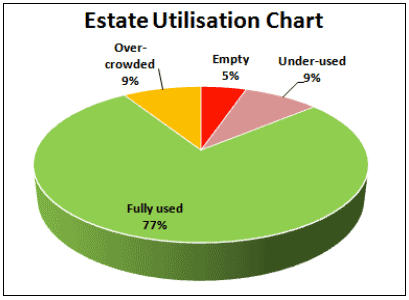
This profile has changed little over the last couple of years and is something that NHS Boards need to concentrate more on.
2.1.5 Estate Functional Suitability
The majority of the estate (68%) is functionally suitable for its current use (categories A and B) but 26% (category C) requires investment to improve its functional suitability and 6% (category D) requires major investment or replacement to achieve satisfactory functionality.
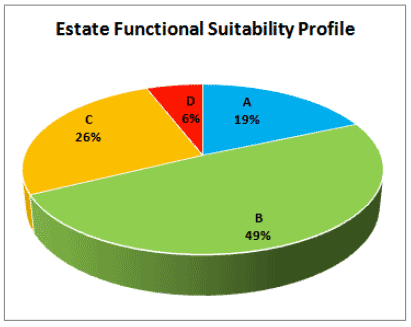
With 68% of the estate providing good, functionally suitable accommodation it is a further indicator that most properties up to 50 years old (72%) are capable of providing such a standard of accommodation.
2.1.6 Estate Backlog
NHSScotland's estate backlog maintenance expenditure requirement is the base cost required to bring those parts of the existing estate which are currently not in satisfactory condition, back to Condition B (satisfactory). It is an on-going challenge for the NHS to balance investment between that which is focussed on service improvement and development, and that which is necessary to maintain buildings in a good condition and ensure that they are safe, reliable and fit for purpose.
An analysis of the backlog expenditure requirement across NHS Boards is shown in the chart that follows and identifies a base backlog maintenance expenditure requirement of £858 million, which is a reduction of £152m since 2011, including a £90 million reduction since 2012.
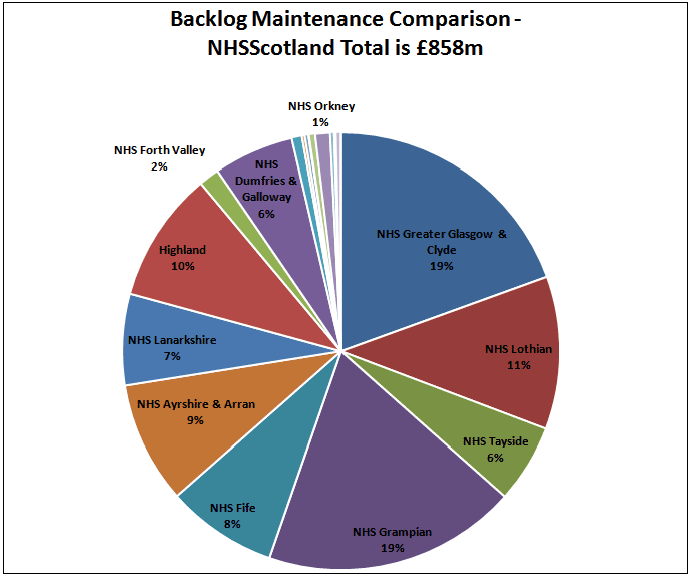
Note: the above chart includes all 22 NHS Boards and Special NHS Boards but those whose backlog is below 1% have not been separately identified for clarity of presentation reasons only.
There are various reasons for the overall reduction in backlog maintenance (£90m) since 2012 and the following summarises some of the more significant reductions across NHS Boards:
- NHS Lothian: £45m backlog reduction.
Combination of completion of 2 capital investment schemes, estate rationalisation, and reassessment of survey data. - National Services Scotland: £12m backlog reduction.
Upgrade of SNBTS accommodation, and office accommodation in Glasgow. - NHS Greater Glasgow & Clyde: £11m backlog reduction.
Targeted backlog maintenance works, plus a reappraisal of part of the estate. - NHS Tayside: £11m backlog reduction.
More robust data reporting. - NHS Dumfries & Galloway: £7m backlog reduction.
Reappraisal of parts of the estate. - NHS Orkney: £7m backlog reduction.
Reappraisal of its hospital accommodation. - NHS Ayrshire & Arran: £6m backlog reduction.
Improvement works to existing accommodation and the reappraisal of parts of the estate. - NHS Lanarkshire: £5m backlog reduction.
Direct investment towards backlog maintenance works, particularly at Monklands Hospital.
Due to reasons of an aging estate and reappraisal of parts of the estate, some NHS Boards have seen an increase in their backlog maintenance.
The total backlog in the estate has been risk assessed and the results of this are shown in the chart that follows.
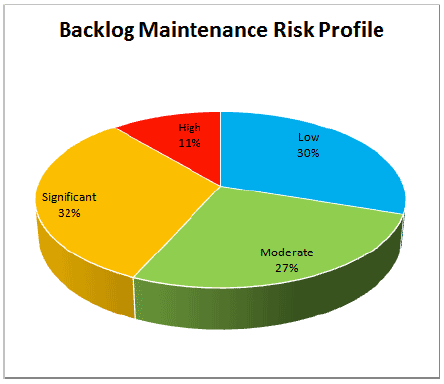
A significant amount of this backlog cost is in buildings which NHS Boards are planning to dispose of in the next ten years. It should also be recognised that around 21% of the current backlog maintenance expenditure requirement is in buildings which are classified as "non-clinical" and will have little impact on the patient's healthcare experience.
Although backlog is identified as expenditure requirement, in practice it is likely to be addressed by a combination of:
- Estate rationalisation and disposal of older properties avoiding the need for expenditure on backlog
- Replacing older properties with new facilities and avoiding the need for expenditure on backlog
- Incorporating backlog works within major modernisation and refurbishment projects
- Undertaking specific projects to target the high and significant backlog
- Incorporating backlog work within operational repair and cyclical maintenance
Therefore, whilst the base backlog expenditure requirement is useful for monitoring "year on year" change in backlog it does not necessarily represent cash requirement in terms of capital or revenue since it can be addressed through the different "non cash" approaches shown above.
Annex B of this report provides further information on the detailed analysis of estate condition and performance (including backlog) which has been undertaken to provide the information in this section of the report.
2.2 Office Accommodation
Properties that provide dedicated office accommodation account for circa 5% of NHSScotland's total property assets and play a vital supporting role towards the effective and efficient delivery of healthcare services. This excludes the office accommodation which is embedded within clinical and other accommodation, which would add further to the overall size of the office estate.
Office accommodation for NHS Boards accounts for 175,000sq.m (4%) of their estate, whereas for Special Health Boards it accounts for 60,000sq.m (40%) of their estate. NHS Boards own 82% of their office accommodation, whereas Special Health Boards lease 78% of their office space, as shown in the chart below.
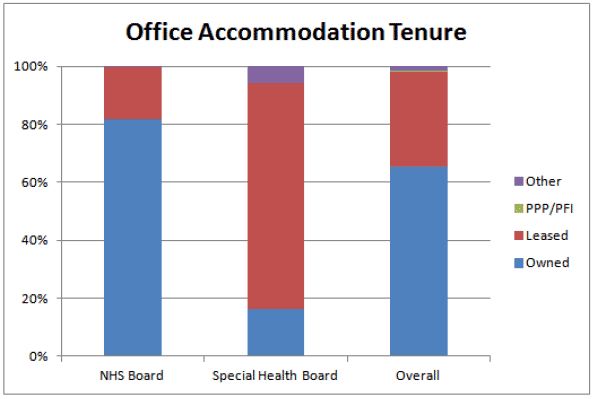
The chart below compares the age profile of office accommodation between NHS Boards and Special Health Boards.
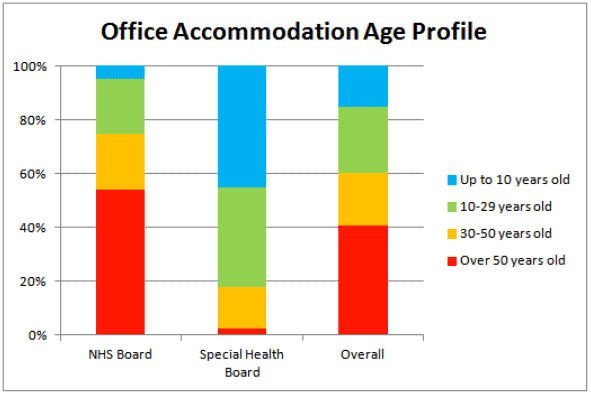
NHS Boards' office accommodation has a much older age profile than that of Special Health Boards. This may reflect the fairly common practice in NHS Boards of adapting older and unsuitable clinical accommodation into office accommodation. The impact of this older asset base in NHS Board office accommodation is also reflected in other performance criteria such as poorer physical condition and functional suitability.
Further details of this performance comparison can be found in Section 5.1.6 Asset Performance Framework for Office Accommodation. The 2014 SAFR will examine in more detail the relative benefits between the different approaches to office ownership.
2.3 Vehicle Assets
Analysis of vehicle assets is based on annual pro-forma information returned by each NHS Board. NHSScotland's vehicle assets comprise of approximately 10,900 vehicles, the majority of which are staff car scheme vehicles (61%) and operational cars (16%). The chart below provides a breakdown of NHSScotland's vehicle assets by type.
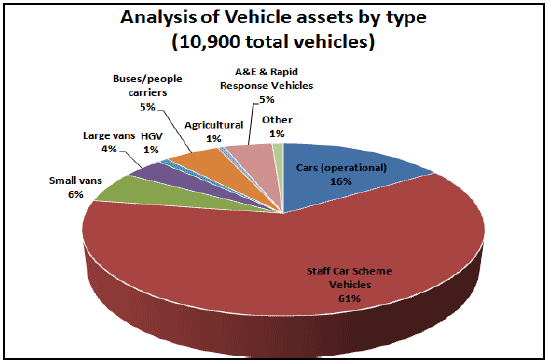
This excludes national logistics vehicles
The distribution of these vehicle assets, and their ownership arrangements across NHS Boards and Special Health Boards is shown in the following two charts:
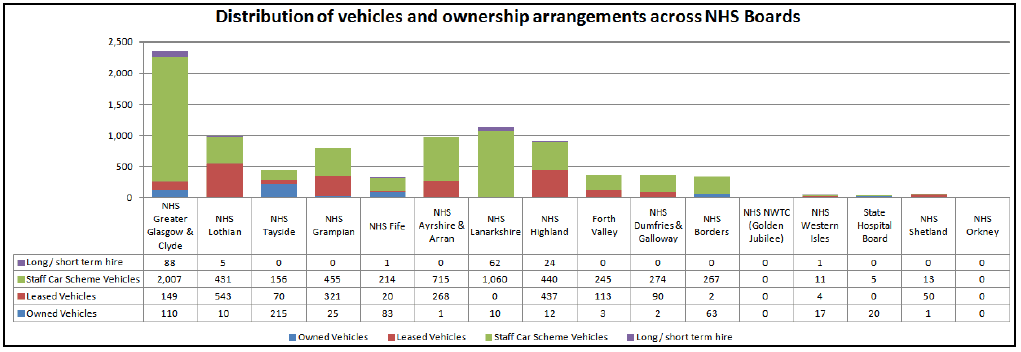
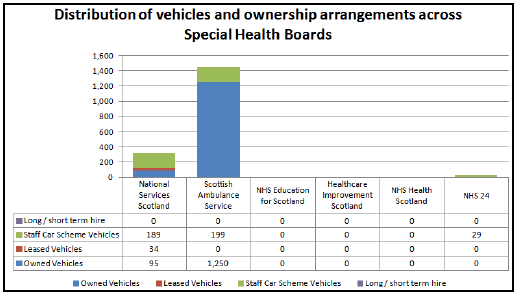
Overall, only 18% of these vehicle assets are directly owned by NHS Boards; the majority of which (65%) are attributed to Scottish Ambulance Service vehicles, 19% are leased, 2% form part of short / long term hire arrangements, and 62% form part of the staff car scheme. The charts above show, however, that these arrangements vary significantly between each NHS Board.
The vehicle age profile is shown below and highlights that circa 41% of the vehicles are less than two years, but with 18% over 5 years old. This represents a reasonable age profile for this asset group and indicates that investment is currently maintaining a reasonable standard of vehicle asset provision. This is also reflected in the overall good / adequate condition of these vehicles, with only 8% considered to be in poor condition, as reported in the further chart below:
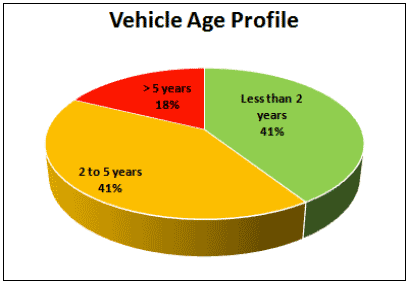
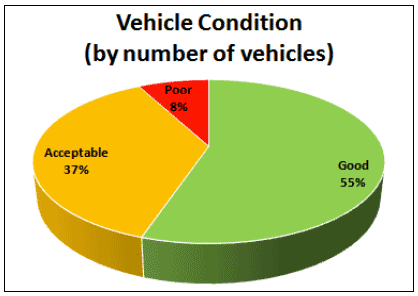
2.4 Medical Equipment Assets
Information has been gathered from each NHS Board and the national imaging and radiotherapy equipment groups to gain a more accurate understanding of the scope and value of medical equipment across NHSScotland. In addition to the global overview of the value of medical equipment, it also sought more detailed information on the following specific equipment types:
- Renal dialysis equipment.
- Cardiac defibrillators.
- Endoscopic equipment.
- Imaging equipment.
- Radiotherapy equipment.
This presented an overall estimated replacement value for Medical Equipment of £760m. The relative value of each equipment type as described above is shown in the following chart:
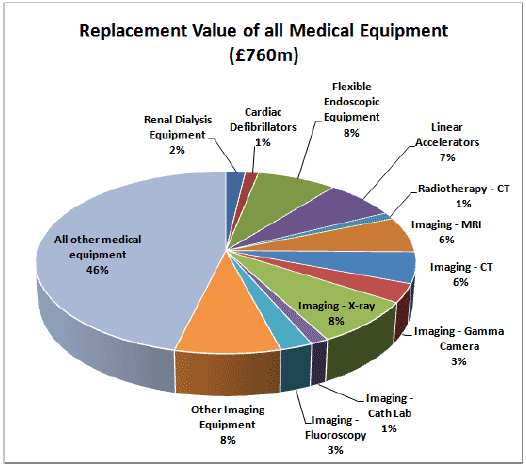
A brief summary of the scope, operational value and funding plans associated with these equipment types is described below:
Renal Dialysis Equipment
Renal dialysis units are life saving facilities for people with renal disorder providing renal replacement therapy. Dialysis machines are critical to these patients quality of life. Dialysis machines are used within acute hospitals and in patients' homes, enabling care in the community. The survey found approximately 930 dialysis machines across NHSScotland with a replacement value of c.£14.2m. These support nearly 200,000 patient sessions per year within dedicated Renal Dialysis Units, with nearly 50 patients dialysed at home. Approximately £2m (14%) was spent in 2012/13 on new equipment which would provide full replacement of this equipment type within 7.1 years (excluding inflationary adjustments). This is considered to be a reasonable investment profile but is tempered by concerns that 33% of units are currently over 7 years old.
Cardiac Defibrillators
A defibrillator is a life-saving machine that gives the heart an electric shock to restore normal heart rhythms in some cases of heart attack. There are 2,160 reported cardiac defibrillators based in hospital environments across NHSScotland, with an average of 8.9 defibrillators per 100 beds and a replacement value of c.£8.7m. Procurements are managed to ensure defibrillator standardisation is crucial to ensure staff familiarity. Approximately £1.3m (15%) was spent in 2012/13 on new equipment, which would provide full replacement of this equipment type within 6.7 years (excluding inflationary adjustments). Defibrillators are expected to have a lifespan of 10 years. The data shows a warning of need for considerable investment in defibrillator replacements over the next few years, with 32% of current units over 7 years old.
Endoscopic Equipment
An endoscope is an investigative and screening device used to examine the inside of the body and to diagnose various conditions. It enables minimal invasive procedures often allowing patients to be treated as outpatients. This survey examined the number of flexible endoscopes in use within Scotland, including those used for upper and lower (covering colonoscopy screening) gastrointestinal examinations. There are 2,647 reported flexible endoscopes across NHSScotland with a replacement value of c.£58m. Approximately £5.6m (10%) was spent in 2012/13 on new units which would provide full replacement of this equipment type within 10.4 years (excluding inflationary adjustments). This is considered to be a minimum acceptable investment profile for such important patient centred equipment. It is also noted that 26.5% of units are currently over 7 years old.
Imaging Equipment
Imaging equipment plays a significant and important role in the provision of healthcare to patients within both the acute and primary care sectors. Diagnostic procedures increased between 2003/04 and 2006/07 by 38% (according to Audit Scotland), and this trend has continued with an increase of 37% between 2006/07 and 2009/10 in the number of patients having a CT, MRI or ultrasound test.
In addition to diagnostic procedures, there is also an increasing number of interventional /therapeutic procedures carried out within imaging directorates. In many cases these have replaced major surgical procedures with minimally invasive procedures that have significantly reduced morbidity and length of hospital stay.
The National Imaging Inventory has an estimated replacement value of £265m (incl VAT and turnkey). The value of equipment out with RCR guidelines (beyond recommended life) is £73m (incl VAT), which has reduced due to national agreement on the asset lives of imaging equipment being stretched by 1 year and the reduced costs of replacing equipment. The annual maintenance charge is £12.4million across the inventory and remains static from previous year.
Radiotherapy Equipment
The 5 Cancer Centres in Scotland have had a co-ordinated national equipment replacement programme in place since 1998, which has been instrumental in ensuring the efficient and timely replacement of radiotherapy equipment across NHSScotland. The continued delivery of cancer access targets is in part due to the timely replacement of ageing equipment.
The timing of replacement of equipment reflects current national recommendations and the programme is managed and monitored by the National Radiotherapy Programme Board with the equipment financed from a ring fenced Scottish Government allocation.
The success of this programme in introducing leading edge technology to enable the best possible treatment for cancer patients; with equity of access across Scotland, is considered to be a best practice model for the management and procurement of medical equipment.
2.5 IM&T Assets
Information on IM&T assets is based on data collected from the eHealth IM&T survey carried out in 2012. The purpose of this survey was to provide a baseline of overall IM&T expenditure within NHSScotland in order that a better understanding could be gained on the current profile of investment in IM&T, identify priority areas for future development and shape future investment plans. The survey also collected information on client devices and peripherals (devices are items such as desktop computers, laptops, tablets etc; whereas peripherals are items that support these devices, such as printers).
Information gathered on client devices and peripherals related to the number of such devices and the following two charts provide a breakdown of this information.
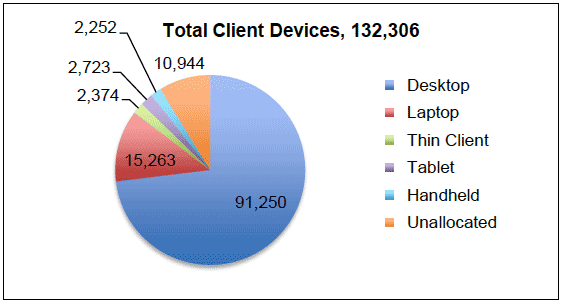
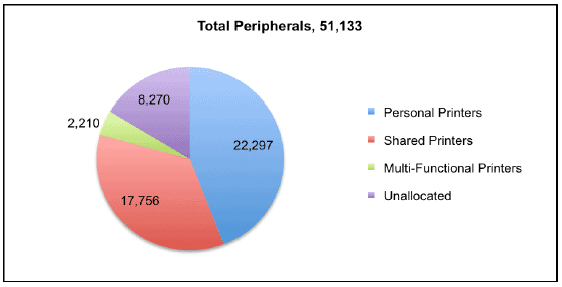
This information can be regarded as a baseline year which NHS Scotland can use to monitor future trends in the use of devices and peripherals. For example, NHS Scotland anticipates that the use of tablets and handheld devices will increase in future as the volume of care provided in the home environment increases and staff work on a more mobile / home working basis. By capturing this basic data, NHS Scotland will be able to monitor trends in device usage and use this information to inform future service planning.
Contact
Email: Gillian McCallum
There is a problem
Thanks for your feedback